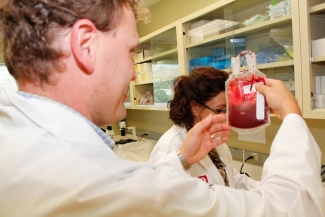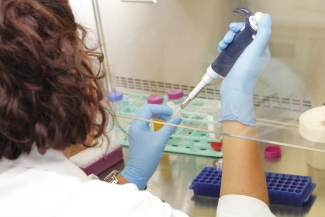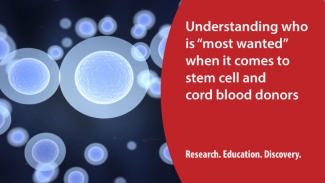July is Cord Blood Awareness Month. Stay tuned for more posts about cord blood and how it helps patients, both through treatment and through research.
To meet a recognized need for a centralized program providing ethnically sourced cord blood for research projects in Canada, Canadian Blood Services, in partnership with The Ottawa Hospital, launched the Cord Blood for Research Program in 2014. Here's what you need to know:
Why is there a need for cord blood research?
On any given day, hundreds of Canadians are in need of an unrelated stem cell donor. Cord blood is a rich source of blood forming stem cells and can be used in the treatment of more than 80 diseases and disorders such as leukemia, lymphoma, and aplastic anemia.
The Cord Blood for Research Program facilitates research that could lead to new discoveries and improvements in patient care. Providing access to cord blood for research is essential to increase our knowledge about current processes for collecting, manufacturing and storing cord blood, and to improve cord blood transplantation outcomes.
Stem cells from cord blood are also being investigated in the development of new treatments for many diseases, providing hope for more safe and effective medical therapies in the future. Other biomedical research unrelated to stem cells may also use cord blood, and lead to new discoveries that may improve medical care in the future.
How do we source the cord blood used for research?
Not all cord blood units are suitable for banking. In fact, the Canadian Blood Services Cord Blood Bank discards some of its cord blood collections, primarily due to insufficient volume, low number of total nucleated cells or low number of stem cells contained in the collected cord blood.
With mothers’ consent, collected cord blood products that do not meet the criteria for storage in the Cord Blood Bank are distributed by the program to approved research projects, reducing the waste of this precious resource. This happens in partnership with our collection sites in Brampton, Edmonton, Ottawa, and Vancouver. Women who deliver at any of these sites are given the option to consent to donate their baby’s cord blood for biomedical research.
What are some of the recent research areas?
The Cord Blood for Research Program is a conduit to promote advances in the fields of transfusion, cellular therapy, and transplantation medicine. In the last fiscal year, the program distributed 155 cord blood units for research. Some recent projects supported with cord blood products from the program include:
-
An automated manufacturing solution for expansion of blood stem cells
-
Cell-based therapy for experimental acute kidney injury
-
Hematopoietic stem cells and transfusion medicine
-
Regulatory T cells from discarded human thymus for adoptive cell immunotherapy: moving garbage to gold
-
Stem Cells of the musculoskeletal system: An epigenetics study from childhood to adulthood
-
Study of immuno-therapeutics anti-tumor efficacy in humanized mice
Our research network works to share findings from this widely to encourage the application of the knowledge created through the program.
During Cord Blood Awareness Month, make some time to learn more about why cord blood matters and our Cord Blood for Research Program. You can also watch this video about donating cord blood.
To donate, visit blood.ca/donatecord.

Canadian Blood Services – Driving world-class innovation
Through discovery, development and applied research, Canadian Blood Services drives world-class innovation in blood transfusion, cellular therapy and transplantation—bringing clarity and insight to an increasingly complex healthcare future. Our dedicated research team and extended network of partners engage in exploratory and applied research to create new knowledge, inform and enhance best practices, contribute to the development of new services and technologies, and build capacity through training and collaboration. Find out more about our research impact.
The opinions reflected in this post are those of the author and do not necessarily reflect the opinions of Canadian Blood Services nor do they reflect the views of Health Canada or any other funding agency.
Related blog posts
Throughout pregnancy, the umbilical cord nourishes the unborn baby with blood rich in nutrients and oxygen. The blood that remains in the cord and placenta after birth is full of stem cells. These cells are like the blood-forming stem cells that can be collected from the bone marrow or circulating...
July marks Cord Blood Awareness Month in certain places around the world. In homage to this important campaign we collected a few related stories from the RED archives and share a bit more information about why Cord Blood matters. Cord blood stem cells can be used in the treatment of more than 80...
On that front, Canada is doing a very good job. Dr. David Allan, medical director for Canadian Blood Services’ Cord Blood Bank and OneMatch Stem Cell and Marrow Network, reports that more than 1,000 units of cord blood are now available in the public Cord Blood Bank.


